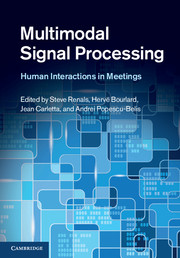Book contents
- Frontmatter
- Contents
- List of contributors
- 1 Multimodal signal processing for meetings: an introduction
- 2 Data collection
- 3 Microphone arrays and beamforming
- 4 Speaker diarization
- 5 Speech recognition
- 6 Sampling techniques for audio-visual tracking and head pose estimation
- 7 Video processing and recognition
- 8 Language structure
- 9 Multimodal analysis of small-group conversational dynamics
- 10 Summarization
- 11 User requirements for meeting support technology
- 12 Meeting browsers and meeting assistants
- 13 Evaluation of meeting support technology
- 14 Conclusion and perspectives
- References
- Index
10 - Summarization
Published online by Cambridge University Press: 05 July 2012
- Frontmatter
- Contents
- List of contributors
- 1 Multimodal signal processing for meetings: an introduction
- 2 Data collection
- 3 Microphone arrays and beamforming
- 4 Speaker diarization
- 5 Speech recognition
- 6 Sampling techniques for audio-visual tracking and head pose estimation
- 7 Video processing and recognition
- 8 Language structure
- 9 Multimodal analysis of small-group conversational dynamics
- 10 Summarization
- 11 User requirements for meeting support technology
- 12 Meeting browsers and meeting assistants
- 13 Evaluation of meeting support technology
- 14 Conclusion and perspectives
- References
- Index
Summary
Introduction
Automatic summarization has traditionally concerned itself with textual documents. Research on that topic began in the late 1950s with the automatic generation of summaries for technical papers and magazine articles (Luhn, 1958). About 30 years later, summarization has advanced into the field of speech-based summarization, working on dialogues (Kameyama et al., 1996, Reithinger et al., 2000, Alexandersson, 2003) and multi-party interactions (Zechner, 2001b, Murray et al., 2005a, Kleinbauer et al., 2007).
Spärck Jones (1993, 1999) argues that the summarizing process can be described as consisting of three steps (Figure 10.1): interpretation (I), transformation (T), generation (G). The interpretation step analyzes the source, i.e., the input that is to be summarized, and derives from it a representation on which the next step, transformation, operates. In the transformation step the source content is condensed to the most relevant points. The final generation step verbalizes the transformation result into a summary document. This model is a high-level view on the summarization process that abstracts away from the details a concrete implementation has to face.
We distinguish between two general methods for generating an automatic summary: extractive and abstractive. The extractive approach generates a summary by identifying the most salient parts of the source and concatenating these parts to form the actual summary. For generic summarization, these salient parts are sentences that together convey the gist of the document's content. In that sense, extractive summarization becomes a binary decision process for every sentence from the source: should it be part of the summary or not? The selected sentences together then constitute the extractive summary, with some optional post-processing, such as sentence compression, as the final step.
- Type
- Chapter
- Information
- Multimodal Signal ProcessingHuman Interactions in Meetings, pp. 170 - 192Publisher: Cambridge University PressPrint publication year: 2012
- 1
- Cited by



